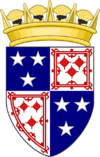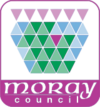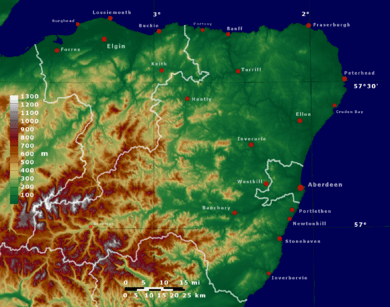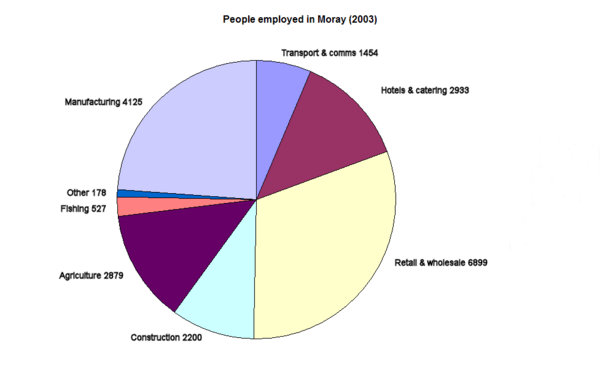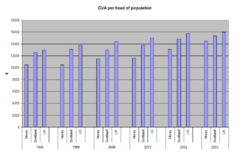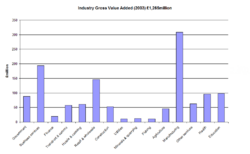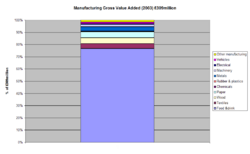Moray facts for kids
Quick facts for kids
Moray
Scottish Gaelic: Moireibh |
|||
|---|---|---|---|
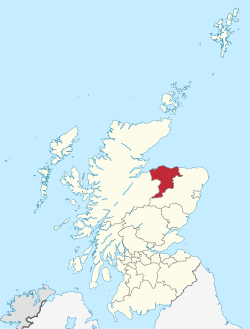 |
|||
|
|||
| Sovereign state | United Kingdom | ||
| Country | Scotland | ||
| Lieutenancy areas | Moray, Banffshire (Part) | ||
| Admin HQ | High Street Elgin Moray IV30 1BX |
||
| Government | |||
| • Body | The Moray Council | ||
| Area | |||
| • Total | 864 sq mi (2,238 km2) | ||
| Area rank | Ranked 8th | ||
| Population
(2020)
|
|||
| • Total | 95,520 | ||
| • Rank | Ranked 22nd | ||
| • Density | 110.543/sq mi (42.681/km2) | ||
| ONS code | S12000020 | ||
| ISO 3166 code | GB-MRY | ||
Moray (pronounced 'MURR-ee') is one of the 32 local government areas in Scotland. It's located in the north-east of the country, right on the coast of the Moray Firth. It shares its borders with Aberdeenshire and Highland.
Between 1975 and 1996, Moray was a "district" within a larger area called the Grampian Region. After that, it became its own independent council area.
Contents
History of Moray
What's in a Name?
The name "Moray" is very old! It first appeared around the year 970 as Moreb. Later, in Latin, it was called Morauia. The name comes from old Celtic words: "*mori*", meaning 'sea', and "*treb*", meaning 'settlement'. So, Moray basically means 'sea settlement'.
Moray in the Middle Ages
During the Middle Ages, the area known as the Province of Moray was much bigger than it is today. It included parts of what are now the Highland and Aberdeenshire areas. For a while, Moray might have even been its own independent kingdom. Or, it could have been a very strong "vassal" (meaning it had a powerful ruler but still owed loyalty to a larger kingdom) of Alba (an early name for Scotland).
In the early 1100s, there was a conflict with Óengus of Moray. David I of Scotland won, and control of Moray went to William fitz Duncan.
The Earls of Moray
The title of "Earl of Moray" was later given to Thomas Randolph in the 1300s. This important title has been created and recreated four times throughout history. The current holder is the 21st Earl of Moray. Over the centuries, the actual land covered by the County of Moray became smaller, focusing mainly around the town of Elgin.
Modern Moray's Boundaries
The current borders of the Moray Council area were set in 1975. From 1975 to 1996, Moray was a district of the Grampian Region. When these regions were removed, Moray became a "unitary authority." This means it's a single council responsible for all local government services.
The Moray Council area includes most of the historic county of Moray. It also covers most of historic Banffshire.
Towns and Villages
Most of Moray's population lives near the coast in the northern part of the area. Elgin is the biggest town by far. About 25% of all people in Moray live there!
Here are some of the largest towns and villages in Moray by population:
| Settlement | Population (2020) |
|---|---|
| Elgin | 25040 |
| Forres | 9900 |
| Buckie | 9010 |
| Lossiemouth | 6840 |
| Keith | 4610 |
| Burghead | 1840 |
| Lhanbryde | 1830 |
| Fochabers | 1770 |
| Hopeman | 1710 |
| Dufftown | 1590 |
Education in Moray
Moray has 45 primary schools and eight secondary schools. The council is in charge of educating over 13,000 students. They also offer many classes and courses for adults who want to keep learning.
Moray Council runs 15 public libraries. All libraries offer free internet and email access. There are also two mobile libraries that visit people in more distant areas.
Moray is home to Moray College, which is part of the University of the Highlands and Islands. It also has Gordonstoun, a famous private boarding school, and its junior school, Aberlour House.
Local Services and Infrastructure
Moray Council is responsible for keeping the area running smoothly. They look after about 1,000 miles of roads and 450 miles of footpaths. They also maintain 468 bridges, 16,000 street lights, and 10,500 road signs.
The council also manages nearly 6,000 council homes. They have a waiting list for these homes. They also provide special housing for older people or those with specific needs. The council's planning team reviews thousands of applications each year. These applications are for building new structures or changing existing ones.
Environment and Recycling
About 50,000 tonnes of waste are collected from homes and businesses in Moray each year. Many communities have a recycling service that picks up recycling right from your home. There are also over 60 recycling points and eight larger recycling centres across Moray.
Economy and Jobs
Jobs in Moray
In 2003, almost 40,000 people worked in Moray. About 34,000 of them were employees, and 6,000 were self-employed. A large number of jobs (31%) were in the public sector, like government or public services. This is more than the average for Scotland or the UK.
Only 18% of jobs in Moray were managerial or professional roles. This is lower than the average for Scotland.
Moray's Economic Strengths
Moray's economy relies a lot on the food and drink industry. This includes whisky distilling, canned food, and biscuit making. The public sector also plays a big role. The food and drink industry makes up 19% of Moray's total economic output. This is much higher than the average for Scotland (3%) or the UK (2%). Moray alone produces 9% of all food and drink in Scotland!
Moray is also strong in tourism, forest products, textiles, and special metal working. However, it has fewer jobs in business services compared to other parts of Scotland or the UK.
In 2014, a plan was started to double the tourism industry in Moray over ten years. A website, morayspeyside.com, was launched to help visitors find information.
Earnings and Businesses
Compared to the rest of Scotland or Britain, average incomes in Moray are a bit lower. This is partly because there are many part-time jobs and fewer high-level professional roles.
About 16% of Moray residents travel outside the area for work. Many of them go to Aberdeen or Inverness to work in the oil and gas industry. These people often earn more than those who work locally.
In 2004, there were about 2,500 businesses in Moray. Most of these were small, with fewer than five employees. Many of Moray's larger companies sell their products to other parts of Britain and even other countries. Smaller companies often work closely with businesses in nearby Aberdeen, Aberdeenshire, and Highland.
Note: This information is from 2003 and 2004.
People of Moray
Someone from Moray, especially from the historic Mormaer of Moray, is called a 'Moravian'.
Source: General Register Office for Scotland.
Different Backgrounds
Moray is home to people from many different backgrounds. Most residents are White, with a large number identifying as Scottish or Other British. Over the years, the number of people from other ethnic groups, such as Asian and Mixed or multiple ethnic groups, has slowly increased.
Here's a look at the different ethnic groups in Moray:
| Ethnic Group | 2001 | 2011 | 2022 | |||
|---|---|---|---|---|---|---|
| Number | % | Number | % | Number | % | |
| White: Total | 86,175 | 99.12% | 92,263 | 98.89% | 91,055 | 97.60% |
| White: Scottish | 69,948 | 80.46% | 72,470 | 77.68% | 68,785 | 73.73% |
| White: Other British | 14,629 | 16.83% | 16,823 | 18.03% | 18,674 | 20.02% |
| White: Irish | 409 | 0.47% | 430 | 0.46% | 514 | 0.55% |
| White: Gypsy/Traveller | – | – | 79 | 0.08% | 87 | 0.09% |
| White: Polish | – | – | 985 | 1.06% | 1,080 | 1.16% |
| White: Other | 1,189 | 1.37% | 1,476 | 1.58% | 1,915 | 2.05% |
| Asian, Asian Scottish or Asian British: Total | 402 | 0.46% | 599 | 0.64% | 913 | 0.98% |
| Asian, Asian Scottish or Asian British: Indian | 71 | 0.08% | 101 | 0.11% | 199 | 0.21% |
| Asian, Asian Scottish or Asian British: Pakistani | 124 | 0.14% | 149 | 0.16% | 152 | 0.16% |
| Asian, Asian Scottish or Asian British: Bangladeshi | 17 | – | 16 | – | 57 | 0.06% |
| Asian, Asian Scottish or Asian British: Chinese | 151 | 0.17% | 164 | 0.18% | 201 | 0.22% |
| Asian, Asian Scottish or Asian British: Asian Other | 39 | – | 169 | 0.18% | 298 | 0.32% |
| Black, Black Scottish or Black British | 19 | – | – | – | – | – |
| African: Total | 36 | – | 88 | 0.09% | 156 | 0.17% |
| African: African, African Scottish or African British | – | – | 78 | 0.08% | 13 | – |
| African: Other African | – | – | 10 | – | 147 | 0.16% |
| Caribbean or Black: Total | – | – | 57 | 0.06% | 111 | 0.12% |
| Caribbean | 54 | 0.06% | 43 | 0.05% | 44 | 0.05% |
| Black | – | – | 11 | – | 15 | – |
| Caribbean or Black: Other | – | – | 3 | – | 52 | – |
| Mixed or multiple ethnic groups: Total | 150 | 0.17% | 232 | 0.25% | 708 | 0.76% |
| Other: Total | 104 | 0.12% | 56 | 0.06% | 352 | 0.38% |
| Other: Arab | – | – | 26 | 0.03% | 116 | 0.12% |
| Other: Any other ethnic group | – | – | 30 | – | 236 | 0.25% |
| Total: | 86,940 | 100.00% | 93,295 | 100.00% | 93,293 | 100.00% |
Languages Spoken
In 1705, most of Moray spoke Scottish Gaelic, especially away from the coast. By 1822, Gaelic was not as common. Only a small part of southern Moray still had many Gaelic speakers.
By the late 1800s, records show that the number of Gaelic speakers in Moray changed over time:
| Year | Gaelic speakers (%) |
|---|---|
| 1881 | 2.63 |
| 1891 | 5.64 |
| 1901 | 4.48 |
| 1911 | 2.98 |
| 1921 | 2.08 |
| 1991 | 0.56 |
Since 1991, fewer than 1% of people in Moray speak Gaelic. The main languages spoken now are Doric (a Scottish dialect) and Scottish English.
See also
 In Spanish: Moray (Escocia) para niños
In Spanish: Moray (Escocia) para niños


